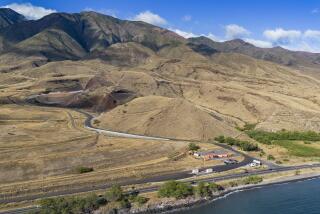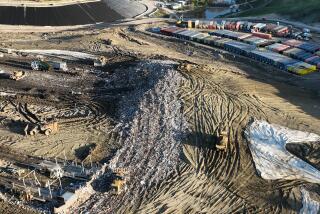Telltale Trash Tries Patience of Dump Critics in Granada Hills : Foes of Landfill Expansion Cite Odors, Traffic, Renegade Refuse
Citizens of Beverly Hills, beware. Residents of Granada Hills are reading your trash.
Letters containing intimate details of your personal lives, tax statements outlining your financial affairs, medical reports listing your physical and mental infirmities--all this and more.
The private lives of people from Santa Monica to Brea are undergoing the same scrutiny.
Why, one might ask?
The answer, my friend, is blowing in the wind.
To be more specific, the wind is blowing the trash from the Sunshine Canyon Landfill above Granada Hills into the yards of residents of the affluent northwestern San Fernando Valley community below.
‘Personal Papers’ Blown
“People in Beverly Hills probably don’t know that their trash is being enjoyed by Granada Hills,” said Mary Edwards, who lives in an upper-middle-class neighborhood about a quarter of a mile beneath the 230-acre dump.
“You get people’s personal papers, and it’s frequently something I’m sure they would not want you to see. Sometimes you get fascinated.”
Edwards and her neighbors can laugh about it, but their jokes barely mask their intense irritation with the dump, which has grown in recent years to one of the five largest landfills in the nation.
Now, Houston-based Browning Ferris Industries, the dump’s owner, has applied to the city and county for permission to more than double the size of the dump, which already takes in 7,000 tons of trash a week, said Greg Smith, chief deputy for Councilman Hal Bernson, in whose district the dump is located. The company wants to extend its operations beyond 1991--the date the existing license expires--well into the 21st Century, officials said.
A small band of Granada Hills and Northridge residents calling themselves the North Valley Coalition are determined not to let this happen.
“Say, ‘No. No more. Dumps don’t belong near people. . . . before they start calling us Stinky Hills,’ ” Granada Hills resident Carol Albright told about 30 of her neighbors at a recent meeting called to rally against the dump, which is located on city and county property.
Bernson, who lives just south of the dump, has vowed to fight its expansion, which would have to be approved by the City Council, the county Board of Supervisors and the state, Smith said.
The residents say the landfill smells up their neighborhood and creates pollution, noise and traffic problems. They also worry that the dump constitutes a health threat, lowers property values and threatens ecologically sensitive areas of the Santa Susana mountains.
They say flurries of flying trash and dust descend on their neighborhood from the dump, particularly between September and January, when winds from the upper deserts whistle through the Newhall Pass at speeds of up to 60 m.p.h.
As proof of the problem, Edwards and her neighbors recently displayed a Neiman-Marcus bag filled with trash gathered by one resident during a 20-minute walk through O’Melveney Park, one of two nearby parks they say are plagued with the debris.
Stock Certificate
The bag’s contents included an oncology clinic’s receipt for a Venice woman’s chest X-rays, a certificate for 1,000 shares of Purex Corp. stock and a March 16, 1985, “near midair collision preliminary report” for an incident involving an Air Cal plane and a private pilot from Woodland Hills.
Also, a “market data” report on the sale of the Brea Village Shopping Center in Brea, a record of telephone calls made from various extensions at Dow Chemical Co. and a KTLA-TV programming schedule for the evening of Oct. 30.
Don Mullally, caretaker of O’Melveney Park, the city’s second largest park after Griffith Park, said he was embarrassed when the Sierra Club and Audubon Society recently came to the park for a hike and were “caught in a cloud of trash like a snowstorm.”
Mullally said he picks up some of the trash himself, as do hikers who use the park. Sometimes, Mullally said, he calls Browning Ferris officials, who have been prompt to send workers. But parts of the park consist of sheer canyon walls and cliffs so steep that no one can reach them safely and easily. There, plastic and paper remain, marring the landscape, Mullally said.
Fill-Dirt Dust
At the close of business each day, the dump is covered with fill dirt to hold the trash in, but even that creates problems, the residents said. “The dust settles in our homes all over everything,” resident Dotti Main said.
Then there are the odors, partly the result of methane gas that occurs at any dump site, Smith said.
“At first, we thought it was a gas leak,” Main recalled. “Then we’d call the gas company. They’d come out and say: ‘Oh, we know what that is. We smelled it before we got off the freeway. That’s your dump.”
Although they have no proof, residents like Fern Eisenberg blame the dump for several cases of cancer, respiratory problems and flu-like symptoms suffered by the dump’s neighbors.
“There is a tremendous smell of noxious odors. I find myself getting very head-achy because of the smell,” Eisenberg said. “I spend a lot of time taking Advil.”
Although the dump technically does not accept hazardous waste, empty cans of paint thinner, pesticides, oven cleaners, motor oil and other hazardous materials are brought to the dump with the usual household trash, Smith said.
There are also aesthetic and ecological concerns. The dump has flattened the contour of the mountain view. “It used to be rolling mountains and hills. Now it goes in a straight line,” Edwards said.
The county territory into which the dump wants to expand is labeled in the county plan as a significant ecological area, partly because of the stands of oak, maple, sycamore and other trees that make it one of the largest hardwood forests in Southern California, officials said.
The area is also rich in wildlife, including bobcats, road runners, coyotes, red-tailed hawks, golden eagles, screech owls and robins, Mullally said.
Ferris Browning has asked the county to change the special ecological designation. The company offered to set aside 100 acres of city land as a nature preserve, said Lee Stark, head of the county Department of Regional Planning impact analysis section. An environmental impact report is being prepared.
Glen Walthausen, the landfill’s safety manager, said he was surprised to hear of any complaints about the dump. He said the company has received only a few complaints about the trash problem in recent months and has responded by picking up the trash immediately.
60-Lot Subdivision
Another complaint, excessive dust, was traced to a 60-lot subdivision under construction near the dump, Walthausen said.
“We’re doing everything we can to be good neighbors,” Walthausen said. “Believe me, when we receive a call, we go take care of it.”
The methane gas problem will probably be solved next month when the company builds a flare device to burn off methane gas, said Smith. The City of Los Angeles intervened with the Air Quality Management District, which had previously denied a permit to build the facility. At present, 85% of the gas escapes into the air, he said.
The company has built earthen berms and hired water trucks to wet down the dirt and stop dust from blowing, Walthausen said.
Although a constant stream of trucks comes to the dump, Councilman Bernson, in response to complaints from residents, last year won council approval to ban trucks from using Balboa Boulevard as a shortcut to the landfill.
The affluent, peaceful neighborhood seems at first a strange place for such a controversy.
70 Tons Per Week
The dump was there first--it opened in 1956 on 1,425 acres of city and county land--but for most of its 30 years of existence, it took in only about 70 tons of trash per week, Smith said.
At one point in the late ‘70s, a precursor to the North Valley anti-dump group calling itself “Dump the Dump” successfully pressured city officials into dropping plans to purchase and expand the dump.
But the dump has grown drastically in recent years as more and more city and county dumps have closed, creating a countywide garbage disposal crisis and political battles between the city and county over trash disposal.
Last December, shortly after the Toyon Canyon Landfill in Griffith Park was closed because of environmentalist objections, the city contracted to dump up to 1,000 tons of trash a day in the landfill. The city, which now dumps 800 tons a day there, hopes to stop using the landfill in the early 1990s after building a trash-burning plant near downtown.
The complaints have come as the dump’s usage has doubled within the last two years from 3,500 tons a year to 7,000, said Smith.
The proposed expansion would include 488 acres of city property and 937 of county land, Stark said. The landfill now gets about one third of the city’s solid waste and about one-sixth of the county’s, officials said.
Public Hearings Planned
An environmental impact statement, requested by the city and county, is being prepared, and public hearings are planned for sometime next year. The process could take years, Smith said.
Although residents say they fear that leaching ground water or airborne particulates from the dump are polluting the nearby Los Angeles Aqueduct and Los Angeles Reservoir, there is no indication that this is happening, Smith said.
Inspectors from the city and county health and sanitation departments and the state Air Quality Management District visit the site weekly and have found no violations, he added.
“There are a lot of unhappy people, a lot of sad people up here. They’re just really disillusioned,” Edwards said. “They bought homes not knowing this was going to happen.”
More to Read
Sign up for Essential California
The most important California stories and recommendations in your inbox every morning.
You may occasionally receive promotional content from the Los Angeles Times.









